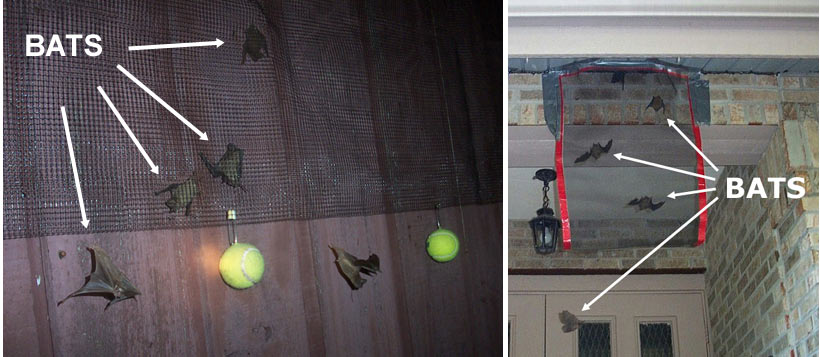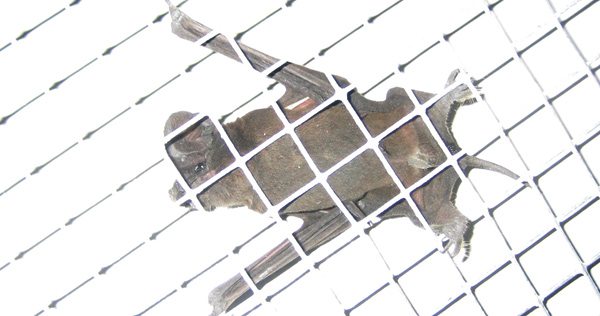-
info@aaanimalcontrol.com
Call us for help in your town
Humane Wildlife Education
How to Trap Bats - Bat Trapping
Need bat removal in your hometown? We service over 500 USA locations! Click here to hire us in your town and check prices - updated for year 2020.
There is really no such thing as professional bat trapping, and bat traps, though they do exist (there's a sucker born every minute), are a terrible option for controlling and
removing bat populations. A professional would never actually trap bats. It just doesn't work, it can be inhumane, or worse - illegal. Many people don't feel satisfied unless
they see an animal hauled away in a trap. If you have a bat problem, please shed that mentality now. Bat trapping is ridiculous. First of all, it's unnecessary. A true bat
professional will completely solve your bat problem 100% correctly without trapping or harming any of the bats. The bats should not be trapped, they should be excluded.
That is, they should be evicted from the attic or structure or building - allowed to fly out, but never fly back in. Second of all, bat trapping is inhumane. Bats are small and fragile
creatures, and they have high metabolisms. If bats are trapped in a cage or box of some sort, they stand a chance of quickly starving or dehydrating, or if left in the sun
dying of heat stroke and exhaustion. Bat traps are condemned by BCI (Bat Conservation International) and anyone with a shred of common sense. Third of all, bats can't be
relocated like other animals can. They can fly, and fast. They will migrate right back to their original home. You may think it can't be done, but many flying animals
possess this ability. In studies, bats relocated as far as 500 miles found their way back to their original home in weeks or even days. Some companies claim to relocate
bats across the state -first of all, not far enough, and second of all, they're liars, I've seen it first hand. Look. Bat control is possible, and there are hundreds of
excellent bat control experts in the country. Professionals who can do the job right, and who do not practice bat trapping.

Look here. In these cases, bats are not being trapped. See how they are flying safely out of the bottom of these nets? These are just two simple and incomplete examples, but
they demonstrate how bats can be evicted without being physically restrained in a trap. Even if you do have a bat trap, I can tell you right now that an amateur (and anyone
equipped with a bat trap would be an amateur) will not solve 90% of the actual bat problems out there. Bat control is difficult and detail oriented
work. Please do not use bat traps or hire anyone who uses bat trapping as part of their bat management program. Get the job done correctly, legally, safely, and effectively.
AAAnimal Control is a professional nuisance wildlife control company located in Orlando, FL. We offer solutions to wildlife problems throughout the Greater Orlando Florida area, and specialize in bat control. We offer professional bat control & removal for the entire state of Florida. For more info, go back to the Florida bat removal page. Wildlife services include animal trapping, capture & removal, plus animal damage repairs and preventative measures. We also offer biological cleanup and many other services. Give us a call at 407-729-6946 any time to discuss your wildlife management issue and schedule an appointment. You can always browse this site for more details and info, and you can even check out prices ahead of time. If you live elsewhere in the US and have found this site and need a local trapper in your area, click here for a nationwide list of 100's of professional bat removal experts.

Trapping is a good way to get rid of rodents and several other animals, but bats are different in this regard and it is not as easy to trap them as one would like to believe. For bats, it is easier and better to exclude them from a house than attempt to trap them. More so there aren?t many trapping methods for bats because they are a protected species and most people after trapping them would probably kill them, not knowing what next to do ? and run afoul of the law.

Trapping does not necessarily translate to killing the animal; sometimes it is a humane way of examining an animal close up, but this is where you have to be careful with a bat because they are carriers of the rabies disease. If bitten, keep the bat so that it could be tested for rabies as you also seek medical attention. If you really still want to trap a bat, here are the three major methods below:
Netting the bats
This involves a box or cage mounted at the exit point of the bats so as to catch the bats as they come out. After trapping, most people might release them but the bats will only come back unless if the entry point has been sealed. Transporting the bats off to a far location and releasing them will not work because they would find their way back to their roost.
Glue board bat trapping
This is an inhumane way of trapping a bat and is mostly used by people ignorantly. Glue boards are placed in the attic where the bats are roosting and a few of them get stuck to the board and starve to death. Remember, there are a minimum of 40 bats in a colony, using this method is not only messy because you would deal with rotting bat bodies; you would also have to re-use the boards or get so many boards. Imagine disposing 40 dead bats that are rotten when you could have just chased them out using the exclusion method.
Home-made traps
This has a trigger and a trap door that shuts on the bat once they enter the cage. The problem with this trap is that you will need a lot since there is usually a minimum of forty bats in a colony.
Other useful techniques that can be used include:
Wet towel
This method works for one bat at a time and you would have to wear gloves and be extra careful because the bat may become aggressive and try to bite you. Drape the towel or blanket over the bat quickly, take it outside and let it go.
Butterfly net
You can also use fishing net. Wait for the bat to land and then throw the net over it, be careful whilst closing the net so that the bat doesn?t get crushed. Take it outside and release it.
Jar trap
Trap it in a jar, wait till it settles and then take it outside and release it carefully. Use a stiff piece of paper and slide it between the wall and rim to trap the bat. Take the jar to a tree, slide the paper out to release the bat.
Why Trapping is Not The Best
Bats are carriers of rabies infection, which can cause brain inflammation and lead to death if you do not start a rabies treatment immediately. Bats? droppings called guano is usually in large amounts and contains tiny airborne spores that if inhaled could cause your lungs to be infected. It can also be treated immediately but may be fatal for those who have an already weak immune system or bronchitis, a chronic lung disease.
The best and the legal way to remove bats from your property still remains - live exclusion. You can get a professional removal expert to install the exclusion devices or if you have enough time on your hands and are careful enough, may attempt the exclusion yourself. The devices come in different forms and for different roosting sites; they ensure that the bats do not come back once they have left.
After ensuring that all the bats are all gone, you must proceed to clean up the attic thoroughly with the protection of gloves and a face mask to avoid you inhaling left over odors.
How to Get Rid of Bats


















